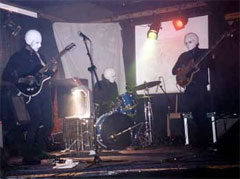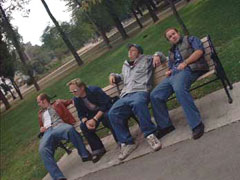For Adam Zahl, the past half year has been busy. Warming up the crowd one humid July night, the mostly Chicago-based band took the stage in the Metro club to open for Latvia’s Prāta Vētra. Next, the band released two albums. And, just last month, it zipped to Latvia for a quick tour with The Hobos. Not bad for a group of guys with day jobs in different cities. But that’s what life can be like for a Latvian band in North America—and Adam Zahl is just one of several with a small but ethnically loyal fan base.
During the half century that Latvian exile culture has flourished in North America, performers of popular music have been a small but strong part of a musical world dominated by folk ensembles and church choirs.
Earlier generations listened to Čikāgas Piecīši, Trīs no Pārdaugavas and other artists, and the latest crop of performers—like Adam Zahl—continue a pattern of adapting contemporary popular music genres to the Latvian language. Folk rock, punk and other styles can be heard in the live performances and recordings of today’s artists.
Here’s a look at several of the bands active in the United States and Canada.
Adam Zahl
Formed last year, Adam Zahl is five guys who share an interest in music and a connection to the Gaŗezers center in south central Michigan. In fact, the name of the group is a play on words, taken from the Latvian ēdamzāle, specifically the food hall at Gaŗezers.
Band members include Kārlis Briedis (guitar), Ēriks Kīns (guitar), Rūdis Pavlovičs (drums), Mārtiņš Šimanis (bass) and Ēriks Kore (saxophone and flute). They had known each other for years, but had played in different groups, such as Yes-I (a reggae band in Latvia), Skandāls, Morālais bankrots, The Minnow Buckets and Bob & The Latvians. Why form a new band? “We’ve known each other for a long time, the time was right, blame it on cosmic convergence,” said Kīns.
“Fundamentally,” he added, “our sound is rock-based with country, reggae, punk, polka and folk influences drawn from the diverse backgrounds of each member.”
Among the band’s recent accomplishments was spending two weekends recording two albums, Lone Tree Road and Pirmā plate. (The former takes its name from the road that runs past Gaŗezers.) As the album titles suggests, Adam Zahl performs in both Latvian and English.
Lusts
Unlike Adam Zahl, the Toronto-area “folk rock” band Lusts performs mostly in English, said Viktors Kūlnieks, one of four members of the group.
The band traces its beginnings back to 1995, when several Latvians in the Toronto area got together to play music. Until 2000, they called themselves Neil on Yonge Street. Today band members include Andrejs Kūlnieks (bass and vocals), Viktors Kūlnieks (guitar and vocals), Mike Rundāns (keyboards) and Aldis Sukse (drums, bass and guitar).
Lusts’ musical influences are broad and include artists such as Neil Young, Black Sabbath, the Grateful Dead, Jauns mēness and others, according to Kūlnieks.
The band has performed about 40 concerts and has released two albums. The more recent one, Vista, was released in December and Kūlnieks described it as “not polished at all.”
“We’re often living on different continents, or at least in different cities,” Kūlnieks told Latvians Online, “so we figured if we didn’t put out the stuff in whatever state we could get it to with us in the same place, we’d never get anything out.”
Although Lusts has not appeared together in Latvia, some band members have performed there, Kūlnieks added.
Mācītājs on Acid
Mācītājs on Acid is known as much for its music as for its outrageous stage presence and offbeat name (which, translated, means Priest on Acid).
Formed in 1992, the “Latvian love punk” band began as a duo: brothers Kristaps (guitar and vocals) and Laris (drums and vocals) Krēsliņš. A bass player by the name of Treiops Treyfid occasionally joined the brothers.
But three years ago, with the addition of cousin Gustavs Mergins (bass), MOA became a trio.
Based in Washington, D.C. (where Kristaps Krēsliņš owns the Pharmacy Bar), MOA kept busy through the 1990s touring Latvia three times and completing three recordings, including Rock Bridge, the band’s first compact disc released as a joint effort with the Ukrainian-American band Kavune.
The group remains active, focusing on live performances rather than recordings.
“MOA’s music is hard to explain,” said Mergins. “It must be experienced. That also explains the paucity of MOA recordings. Every concert is an event and every concert is different.”
The band also is intent on performing in Latvian, although in concerts it projects translated lyrics onto a screen so non-Latvians can understand.
“MOA sings in Latvian because rock songs in German sound completely stupid,” Mergins said, “and none of us knows Spanish.” Latvian, he said, is a natural language for rock music. “Besides, there are enough groups that sing in English.”
The band returned to Latvia in 2001 and, Kristaps Krēsliņš said, plans to “conquer” it again this summer “with our weapons of love.” By that time, a new album could be ready as well.
Agrais Pīrāgs
Hailing from Chicago and Ontario, Agrais Pīrāgs is among the younger of the current Latvian bands. The group includes Jānis Kļaviņš (guitar and vocals), Rob Ozoliņš (drums), Yuri Eliashevsky (bass), Kārlis Kanderovskis (guitar and vocals) and Austris Siliņš (guitar and voice).
The band describes its music as Latvian punk. “We took the traditional latvian songs that everyone knows, made them faster, louder, added a ‘punk’ flavor, more vocal harmonies, and just a ‘wall of sound’ feel,” said Kļaviņš. “It adds a lot more energy, and it gets the crowd really excited and wanting to sing along.”
Kļaviņš said Agrais Pīrāgs has drawn its influences from American punk music as well as from Latvian-American bands like Akacis and Skandāls.
Like other bands, Agrais Pīrāgs has been making the round of youth events, such as November’s congress of the American Latvian Youth Association in Chicago and the young artists’ exhibition, Šī māksla ir jauna, in Toronto last month.
The band began forming in the summer of 2000 while a number of the original members were working at the Gaŗezers center or attending the summer high school there. In November of last year, Agrais Pīrāgs (a Latvian expression meaning “jumping the gun”) released its first album, Tic vai ne Tic. A second album is expected this year.
While the band hasn’t played in Latvia yet, it is planning to tour there this summer, Kļaviņš said.
Skandāls
In another year, Skandāls will be able to celebrate its 20th anniversary. The Toronto-based band was founded in 1984 before that year’s song festival in Canada because, explains band member Alberts Vītols, no other band wanted to be the first to perform during the festival’s “rock night.”
During those two decades, the band has had a number of members, but its current lineup includes Vītols (guitar and vocals), Maria Thorburn (vocals), Mike Morrow (drums), Andris Daugavietis (bass) and Andris Krūmiņš (guitar).
Highlights of the band’s career have included performing before an estimated 50,000 people during the Rīga 800 celebrations two years ago. Calls to perform have taken the band across North America and Europe, Vītols said.
But, so far, the band has put out only one album. Vajag’ smērēt was released on cassette in 1986 and re-released on CD three years ago. Skandāls in 2001 also recorded four songs in the UPE Recording Co.‘s studio in Sigulda, Latvia.
“There are a few songs that we have performed that might be considered ‘hits’ in one way or another,” Vītols said. “Some of these songs are ‘Tevi vien,’ ‘Domas par mājām,’ ‘Jā gan!,’ ‘Paga, paga’ and ‘Vajag’ smērēt.’”
Other artists
Adam Zahl, Lusts, Mācītājs on Acid, Agrais Pīrāgs and Skandāls are not the only rock music artists who have become known to at least some segments of the Latvian community in North America.
For example, Linda Maruta in 2000 released her first recording, the straightforward rock album Buttercup, and has garnered some success in Toronto and in Rīga. She’s now looking at releasing a second album this year, according to her Web site.
These and other Latvian artists have at least one thing in common with earlier generations that have had to pursue their musical careers outside the homeland. They have managed, despite the demands on their lives and the distances that often separate them, to create music and a develop a base of fans. At least these days it’s a bit easier to make the leap back to Latvia.
(Editor’s note: An earlier version of this article appeared in the Latvian music magazine, Mūzikas Saule.)

Stage performances by Mācītājs on Acid feature unusual costumes. (Photo courtesy of Mācītājs on Acid)

Four of the five members of Agrais Pīrāgs relax in a park. (Photo courtesy of Agrais Pīrāgs)
© 1995-2024 Latvians Online
Please contact us for editorial queries, or for permission to republish material. Disclaimer: The content of Web sites to which Latvians Online provides links does not necessarily reflect the opinion of Latvians Online, its staff or its sponsors.




